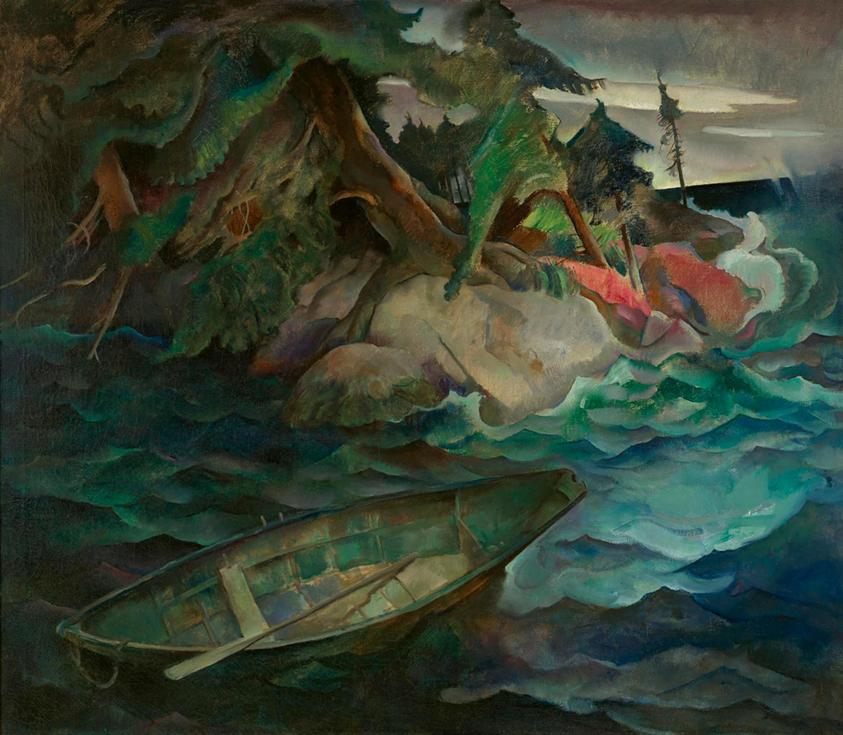Artist:
N.C. Wyeth
(American, 1882 - 1945)
The Drowning
Medium: Oil on canvas
Date: 1936
Dimensions:
42 1/16 × 48 1/8 in. (106.8 × 122.2 cm)
Brandywine Museum of Art, Bequest of Carolyn Wyeth, 1996
Accession number: 96.1.40
Label Copy:
N.C. Wyeth’s experimental expressionist style found a well-matched subject in his painting The Drowning. The impossibly tilted dory in the foreground completes the story begun by the title of the painting. Wyeth made the work in response to the death of sixteen-year-old Douglas Anderson, the Wyeth family’s friend and neighbor in Port Clyde, Maine. Anderson disappeared while lobstering in September 1935, after the Wyeths had returned to Chadds Ford for the winter. Months later, Anderson’s father and younger brother Walt, found the boy’s body floating in the water off Horse Point—a rocky, tree strewn landscape very similar to that which is rendered by Wyeth. His stormy sea kicks up sharp-edged waves tossing the empty boat, which itself played a painful role in the tragedy: Anderson was not in the sturdy dory represented by Wyeth, but in a much more flimsy skiff, a craft sadly unsuited for his task.
N.C. Wyeth’s experimental expressionist style found a well-matched subject in his painting The Drowning. The impossibly tilted dory in the foreground completes the story begun by the title of the painting. Wyeth made the work in response to the death of sixteen-year-old Douglas Anderson, the Wyeth family’s friend and neighbor in Port Clyde, Maine. Anderson disappeared while lobstering in September 1935, after the Wyeths had returned to Chadds Ford for the winter. Months later, Anderson’s father and younger brother Walt, found the boy’s body floating in the water off Horse Point—a rocky, tree strewn landscape very similar to that which is rendered by Wyeth. His stormy sea kicks up sharp-edged waves tossing the empty boat, which itself played a painful role in the tragedy: Anderson was not in the sturdy dory represented by Wyeth, but in a much more flimsy skiff, a craft sadly unsuited for his task.
Research Number: NCW: 952
Inscribednone
ProvenanceThe artist; Mrs. N. C. Wyeth; Carolyn Wyeth
Exhibition HistoryChadds Ford, PA, 1995, no. 25 p.52, illustration in b/w p. 54; Burlington, VT, Shelburne Museum, "Wyeth Vertigo," June 22-Oct. 31, 2013, illus. p. 17, see also p. 23; Chadds Ford, PA, Rural Modern, American Art Beyond the City, Oct. 29, 2016-Jan. 22, 2017, plate no. 54; Chadds Ford, PA, Brandywine River Museum of Art, June 22-Sept. 15, 2019 (and Portland, ME, Portland Museum of Art, Oct. 4, 2019-Jan. 12, 2020, and Cincinnati, OH, Taft Museum, Feb. 8-May 3, 2020), "N. C. Wyeth: New Perspectives," illus. p. 185; Salem, MA, Peabody Essex Museum, May 29 - Oct. 3, 2021 (and Bentonville, AR, Crystal Bridges Museum of American Art, Nov. 6, 2021-Jan. 31, 2022), "In American Waters: The Sea in American Painting," illus. p. 200, fig. 115, see also p. 194;
References
Richard Layton, "Inventory of Paintings in the Wyeth Studio, 1950, " unpublished, Wyeth Family Archives, p. 83; Christine B. Podmaniczky, N. C. Wyeth, Catalogue Raisonne of Paintings (London: Scala, 2008), P.50, p. 822, 823; Amanda C. Burdan, "Off the Beaten Path: Aspects of Rural Modernism" in Rural Modern: American Art Beyond the City (NY: Rizzoli, 2016), p. 23, illus. in color, plate 54; "The Power of Place in American Art, 1915-1950," American Art Review, xxix, no. 1 (Feb. 2017), illus. in color, p. 104; Austen Barron Bailly and Daniel Finamore, "Beachcombing" in In American Waters: The Sea in American Painting (Fayetteville, AR: University of Arkansas Press, 2021), p.194, illus. in color p. 200;
Curatorial RemarksAndrew Wyeth remembered that this canvas was painted in reaction to the death of Douglas Anderson, older brother of Andrew's model Walter Anderson. Anderson, a 16-year-old fisherman, drowned off Harper's Point, Port Clyde, September 24, 1936. "The Painter and the Pirate" by Edgar Allen Beam (Down East, Sept. 2001, ps. 40-45, 74-79) gives an account of the accident.
The canvas recalls a 1933 painting by Carolyn Wyeth, The Dark Shore (Brandywine River Museum, 85.10.99). The Brandywine River Museum holds an archival photograph of the present work from the artist's collection, stamped on the reverse: SANBORN STUDIO / WIL., DEL.
On the reverse of the canvas there is a faint composition drawing for an unidentified image.
The canvas recalls a 1933 painting by Carolyn Wyeth, The Dark Shore (Brandywine River Museum, 85.10.99). The Brandywine River Museum holds an archival photograph of the present work from the artist's collection, stamped on the reverse: SANBORN STUDIO / WIL., DEL.
On the reverse of the canvas there is a faint composition drawing for an unidentified image.
Image Source for printed Catalogue Raisonne:transparency directly from painting
Photo Credit:Brandywine River Museum photography files
On view

